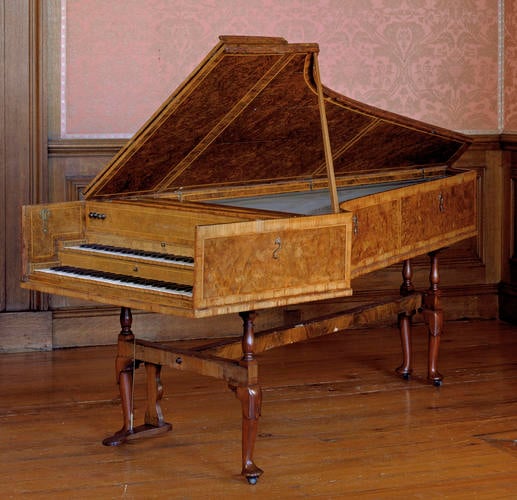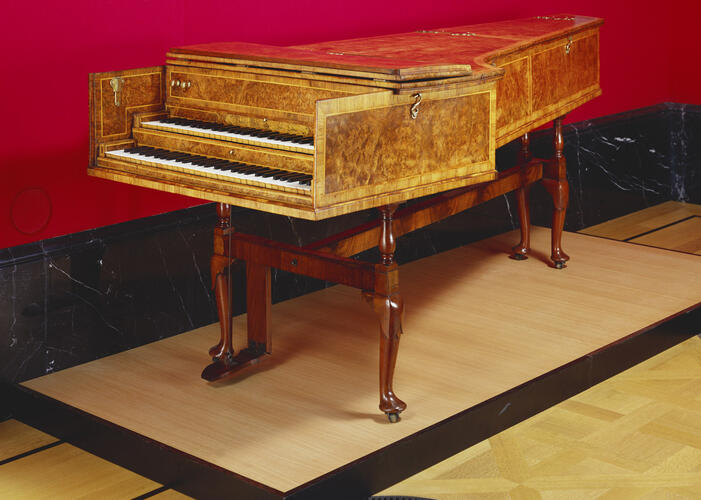-
1 of 253523 objects
Two-manual harpsichord 1740
Burr walnut veneered case with satinwood cross-banding | 96.0 x 95.0 x 246.0 cm (whole object) | RCIN 11896
-
Burr walnut veneered two-manual harpsichord, satinwood cross-banding, long side without veneer; two-tier keyboard with 36 keys each; the lid hinged in two sections; resting on four turned and cabriole legs with castors, joined by stretchers; single foot pedal.
Both George III and Queen Charlotte were regular and competent players of the harpsichord. The King purchased three instruments in February 1764: one from 'Capt. Shadwell' and two from Jacob Kirkman (1710-92), who was also paid a quarterly retainer for tuning the Queen's harpsichord during the 1760s and early 1770s. A 'Harpsichord Case ornamented with Painting in the Stile of Polidoro', charged at 50 Roman crowns, was among the objects purchased at Rome for the King and Queen by Richard Dalton in the late 1760s; that instrument is not traceable today. The newly married couple held private concerts every week at St James's, at which 'The Queen and Lady Augusta play on the Harpsichord & sing, the Duke of York plays on the Violoncello, & P. William on the German Flute'.
The Swiss-born keyboard-instrument-maker Burkhardt Tschudi came to London in 1718, after which he began to use an anglicised form of his name. He was employed by Frederick, Prince of Wales, as a tuner and supplied two spinets in 1751, for the young Prince George and for his sister Augusta. This instrument is one of the earliest of his harpsichords to survive, from a considerable output spanning the years from 1729 to 1793, by which time Shudi's son-in-law John Broadwood had taken over the firm. Recent conservation work has revealed that this instrument was originally made as the harpsichord component of a claviorgan, superimposed on a chamber organ of the same outline shape. Shudi is known to have made such instruments with the organ-builder John Snetzler (1710-1785), and Handel is thought to have used one in performing his oratorio Saul in 1738. The choruses were accompanied on the organ and the recitatives and arias on the harpsichord, played from the same keyboard. Claviorgans seem to have proved difficult to maintain, and at some point later in the eighteenth century this harpsichord was separated from its organ. This is conceivably the instrument listed in the 1825 inventory of Buckingham House.
This instrument was originally much larger: it was formerly a claviorgan, part-harpischord, part-chamber organ, of which today only the harpsichord element survives.
Signed in pen on the upper name batten Burkat Shudi fecit Londini. Inscribed in pencil on the upper surface of the lever of the lowest note of the lower manual 94 f 1740
Catalogue entry adapted from George III & Queen Charlotte: Patronage, Collecting and Court Taste, London, 2004 and The First Georgians: Art and Monarchy 1714 - 1760, London, 2014Provenance
Possibly commissioned or purchased by Frederick, Prince of Wales; first recorded at Buckingham Palace in 1825.
-
Creator(s)
(instrument maker)Acquirer(s)
-
Medium and techniques
Burr walnut veneered case with satinwood cross-banding
Measurements
96.0 x 95.0 x 246.0 cm (whole object)
Category
Object type(s)


